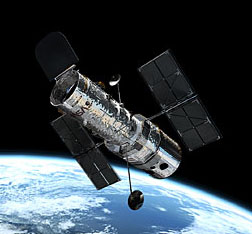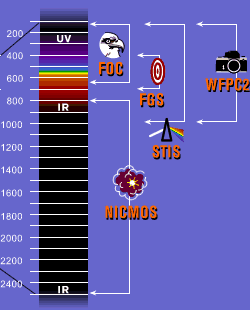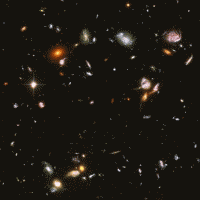Reasons for observing in space has already been
covered in
Space Observatories so I will not repeat it
here. What will be mentioned here is the
breakthrough observations of the Hubble Space
Telescope.The
"un-official" Hubble Space Telescope website is
a good visit.
Also of interest in a website full of obscure
facts and information on space exploration -
AeroSpaceGuide.
For your dose of Hubble News, visit the
HubbleSite News Center.
Much of our ideas of a wide variety of
phenomenon have been reshaped thanks to this
remarkable telescope. The success is mainly due to
lack of
atmospheric interference - the bane of
astrophotographers here on Earth. Sure the adaptive
optics breakthrough of the Keck
telescopes have
circumvented the atmospheric interference problem,
but nothing beats removing that affect altogether.
Because the Hubble is in space and does not suffer
from daylight, some of the deepest and most dramatic
photographs have been released.
 |
The Hubble Space Telescope
concept was initially discussed back in
1960's and scientific proposals for the
telescope was drafted in 1977.
Original orbital insertion date of the
telescope scheduled for 1983. Cost
delays and the loss of the Space Shuttle
Challenger in 1986 pushed back Hubble's
orbital insertion to 1990.
Original plans dictated an operation status
of 15 years. |
The Hubble has been active for 14 years and
is still running strong. The instrumentation of
Hubble:
- A 2.4 meter primary mirror using a
Ritchey-Chretien design
- Advanced Camera for Surveys - ACS: study
planetary atmospheres, study groups of
galaxies
and overall generalized imagery
- Wide Field and Planetary Camera - WFPC2:
most images are captured with this piece of
equipment
- Near Infrared Camera and Multi-Object
Spectrometer - NICMOS: sees more heat than
light, allows penetration of dust clouds within
our galaxy.
- Space Telescope Imaging
Spectrograph - STIS:
allows study of spectra
- Fine Guidance Sensor - FGS: allows Hubble to
stay on target
 |
Because the Hubble Space Telescope
is outside our Earth's
atmosphere, the
telescope and its instrumentation allow
for a much larger portion of the
EM-band
to be studied. Each of the instruments
onboard are specifically tuned for a
specific region of the
EM-band, but as a
hole cover an area far greater than any
traditional
telescope on Earth.
Hubble is in what is called a
"low-Earth orbit," only 600km above the
surface. One orbit of Hubble takes about
96 minutes. |
Additional information on the history and
timeline of the Hubble can here found at the
ESA's Hubble Space Telescope website.
| Possibly the greatest achievement of
the Hubble telescope is the Hubble Deep
Field. The latest deep field image was
released on March 9, 2004. Every object
is this image is a
galaxy, some 10,000
of them. Over 800 exposures, 400 orbits,
and a total exposure time of 11.3 days
resulted in the deep field image on the
right. This is an example of what a
space based observatory can do. |
 |
A few of Hubble's Greatest Hits:
There have been 3 major Servicing Missions -
or SM's - with a forth initially scheduled for
January 2004. The loss of the Space Shuttle
Columbia in February 2003 forced NASA to cancel
that mission. Although the public and
scientific communities are angered by NASA's
decision, it should be know that the Hubble, in
its current state, is predicted to be
operational until the years 2007 to 2008.
Details of the Assessment report release in
January 2005 can be found on the
Hubble Space Telescope website. The
successor to Hubble is the
Next Generation Space Telescope - or NGST.
Currently in its design stages, predicted launch
is said to be around January 2008 - about the
time the Hubble is predicted to shut down. Back to
Top |

